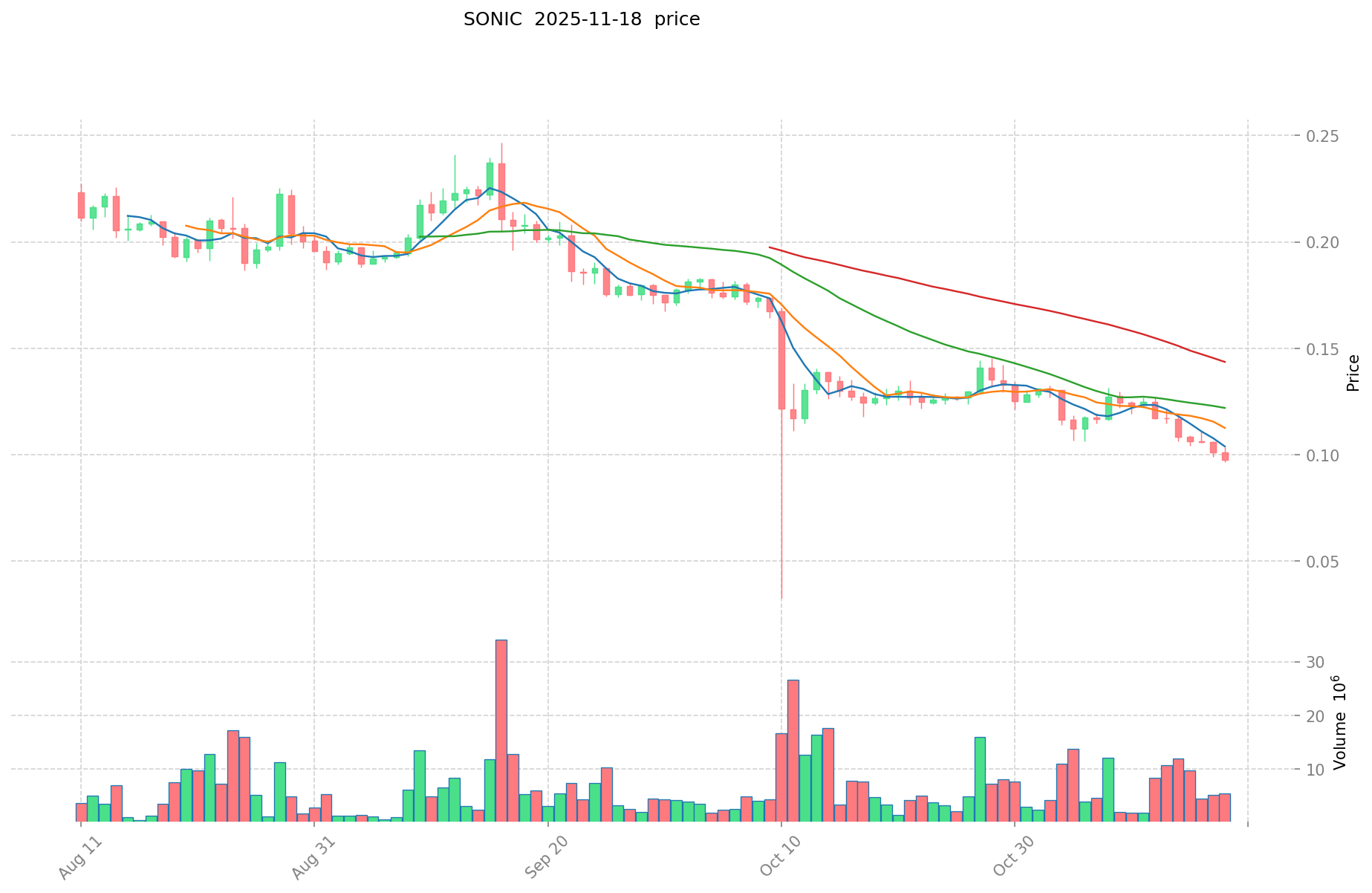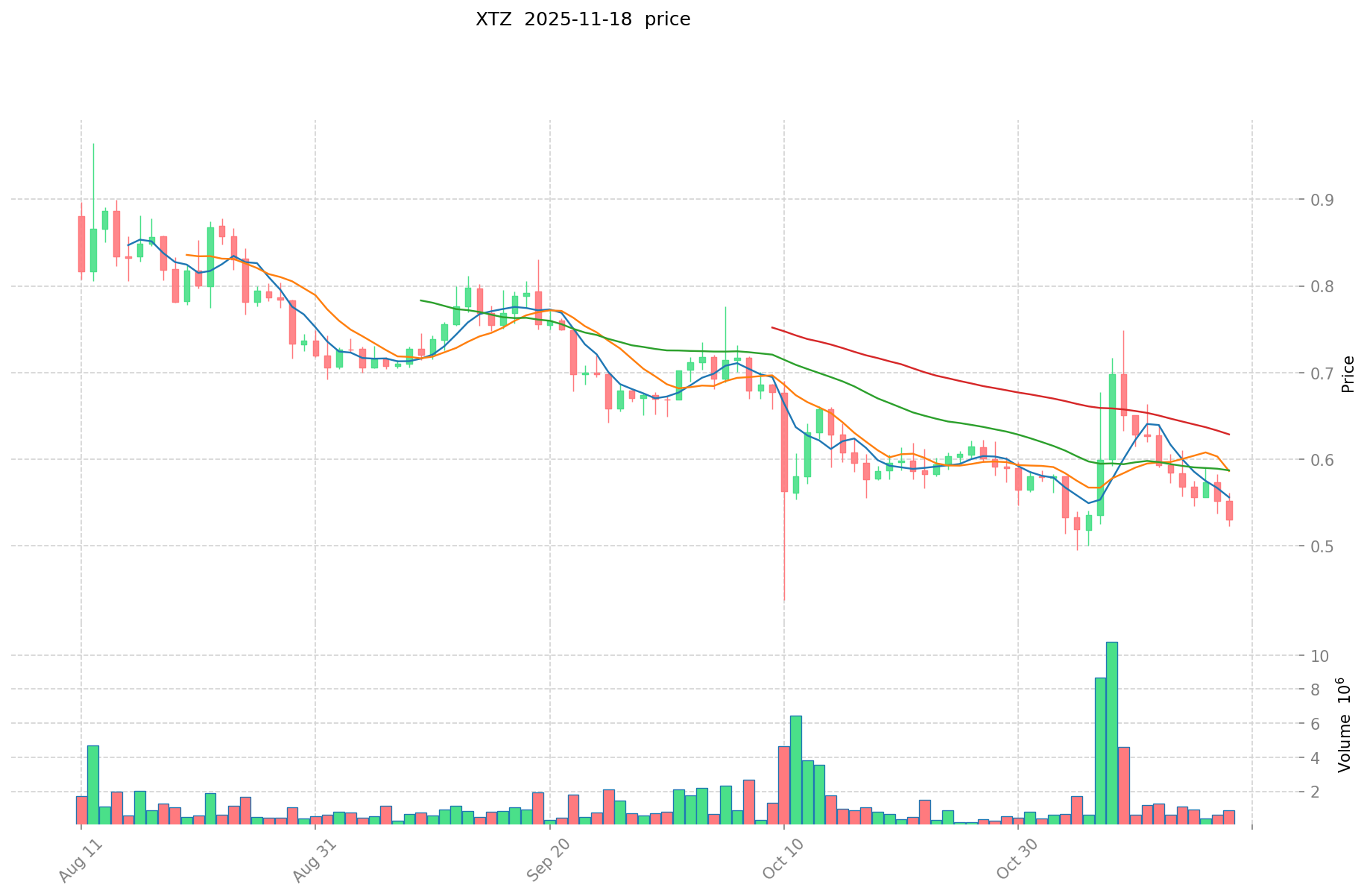SONIC vs XTZ: Comparing Speed and Performance in Blockchain Networks
Introduction: Investment Comparison between SONIC and XTZ
In the cryptocurrency market, the comparison between SONIC vs XTZ has been an unavoidable topic for investors. The two not only show significant differences in market cap ranking, application scenarios, and price performance, but also represent different positions in crypto assets.
Sonic SVM (SONIC): Launched as the first SVM network extension on Solana for games and applications, powering the Web3 TikTok App Layer.
Tezos (XTZ): Introduced in 2017, it has been recognized as a self-amending cryptographic ledger, offering a platform for smart contracts and decentralized applications.
This article will comprehensively analyze the investment value comparison between SONIC vs XTZ, focusing on historical price trends, supply mechanisms, institutional adoption, technological ecosystems, and future predictions, attempting to answer the question investors care about most:
"Which is the better buy right now?" I. Price History Comparison and Current Market Status
SONIC and XTZ Historical Price Trends
- 2025: SONIC launched on Solana as the first SVM network extension, causing significant price volatility.
- 2021: XTZ reached its all-time high of $9.12 in October, driven by increased adoption and ecosystem growth.
- Comparative analysis: During the recent market cycle, SONIC dropped from its all-time high of $1.225 to a low of $0.03238, while XTZ declined from $9.12 to its current price level.
Current Market Situation (2025-11-18)
- SONIC current price: $0.09848
- XTZ current price: $0.5364
- 24-hour trading volume: SONIC $636,495.76 vs XTZ $420,550.83
- Market Sentiment Index (Fear & Greed Index): 11 (Extreme Fear)
Click to view real-time prices:
- Check SONIC current price Market Price
- Check XTZ current price Market Price


II. Core Factors Affecting SONIC vs XTZ Investment Value
Supply Mechanism Comparison (Tokenomics)
- SONIC: Connected to Fantom ecosystem, reward-based distribution model
- XTZ (Tezos): Self-amending governance model with staking rewards
- 📌 Historical pattern: Market dynamics typically drive periodic interest cycles in both assets.
Institutional Adoption and Market Applications
- Institutional holdings: Tezos has attracted more established institutional interest
- Enterprise adoption: Tezos shows stronger application in cross-border payments and settlements
- Regulatory attitudes: Both projects face varying regulatory approaches across jurisdictions
Technical Development and Ecosystem Building
- SONIC technical upgrades: Connected to Fantom's infrastructure with developer activity ranking lower
- XTZ technical development: Etherlink L2 solution showing significant TVL growth from $18M to $40M
- Ecosystem comparison: Tezos demonstrates stronger DeFi applications with Apple Farm driving substantial TVL growth
Macroeconomic and Market Cycles
- Performance in inflationary environments: Both subject to broader cryptocurrency market dynamics
- Macroeconomic monetary policy: Both influenced by interest rates and USD strength
- Geopolitical factors: Trust and transparency form the foundation for both projects' cross-border adoption
III. 2025-2030 Price Prediction: SONIC vs XTZ
Short-term Prediction (2025)
- SONIC: Conservative $0.0580678 - $0.09842 | Optimistic $0.09842 - $0.137788
- XTZ: Conservative $0.279188 - $0.5369 | Optimistic $0.5369 - $0.746291
Mid-term Prediction (2027)
- SONIC may enter a growth phase, with estimated price range of $0.0960894144 - $0.1708256256
- XTZ may enter a bullish market, with estimated price range of $0.677524848 - $0.973941969
- Key drivers: Institutional capital inflow, ETF, ecosystem development
Long-term Prediction (2030)
- SONIC: Base scenario $0.20826659900592 - $0.266581246727577 | Optimistic scenario $0.266581246727577+
- XTZ: Base scenario $1.068329296509475 - $1.153795640230233 | Optimistic scenario $1.153795640230233+
Disclaimer: This analysis is based on historical data and market projections. Cryptocurrency markets are highly volatile and unpredictable. This information should not be construed as financial advice. Always conduct your own research before making investment decisions.
SONIC:
| 年份 | 预测最高价 | 预测平均价格 | 预测最低价 | 涨跌幅 |
|---|---|---|---|---|
| 2025 | 0.137788 | 0.09842 | 0.0580678 | 0 |
| 2026 | 0.14881104 | 0.118104 | 0.09566424 | 19 |
| 2027 | 0.1708256256 | 0.13345752 | 0.0960894144 | 35 |
| 2028 | 0.203869707552 | 0.1521415728 | 0.101934853776 | 54 |
| 2029 | 0.23852755783584 | 0.178005640176 | 0.12994411732848 | 80 |
| 2030 | 0.266581246727577 | 0.20826659900592 | 0.141621287324025 | 111 |
XTZ:
| 年份 | 预测最高价 | 预测平均价格 | 预测最低价 | 涨跌幅 |
|---|---|---|---|---|
| 2025 | 0.746291 | 0.5369 | 0.279188 | 0 |
| 2026 | 0.7699146 | 0.6415955 | 0.404205165 | 19 |
| 2027 | 0.973941969 | 0.70575505 | 0.677524848 | 31 |
| 2028 | 0.89023942007 | 0.8398485095 | 0.730668203265 | 56 |
| 2029 | 1.27161462823395 | 0.865043964785 | 0.70068561147585 | 60 |
| 2030 | 1.153795640230233 | 1.068329296509475 | 1.03627941761419 | 98 |
IV. Investment Strategy Comparison: SONIC vs XTZ
Long-term vs Short-term Investment Strategies
- SONIC: Suitable for investors focused on gaming and Web3 application potential
- XTZ: Suitable for investors seeking established ecosystems and institutional adoption
Risk Management and Asset Allocation
- Conservative investors: SONIC: 20% vs XTZ: 80%
- Aggressive investors: SONIC: 40% vs XTZ: 60%
- Hedging tools: Stablecoin allocation, options, cross-currency portfolios
V. Potential Risk Comparison
Market Risk
- SONIC: Higher volatility due to newer market presence
- XTZ: Subject to broader cryptocurrency market fluctuations
Technical Risk
- SONIC: Scalability, network stability
- XTZ: Smart contract vulnerabilities, upgrade implementation challenges
Regulatory Risk
- Global regulatory policies may impact both differently, with XTZ potentially facing more scrutiny due to its longer market presence
VI. Conclusion: Which Is the Better Buy?
📌 Investment Value Summary:
- SONIC advantages: First SVM network extension on Solana, potential in gaming and Web3 applications
- XTZ advantages: Established ecosystem, institutional adoption, self-amending governance model
✅ Investment Advice:
- New investors: Consider a balanced approach with a higher allocation to XTZ for stability
- Experienced investors: Explore SONIC for higher growth potential while maintaining XTZ for ecosystem exposure
- Institutional investors: Focus on XTZ for its established presence and regulatory compliance track record
⚠️ Risk Warning: The cryptocurrency market is highly volatile. This article does not constitute investment advice. None
VII. FAQ
Q1: What are the key differences between SONIC and XTZ? A: SONIC is the first SVM network extension on Solana for games and Web3 applications, while XTZ (Tezos) is an established self-amending cryptographic ledger for smart contracts and dApps. SONIC is newer with a focus on gaming and Web3, while XTZ has a longer track record and stronger institutional adoption.
Q2: Which cryptocurrency has shown better price performance recently? A: As of November 18, 2025, SONIC's current price is $0.09848 with a 24-hour trading volume of $636,495.76, while XTZ's price is $0.5364 with a trading volume of $420,550.83. However, past performance doesn't guarantee future results.
Q3: How do the supply mechanisms differ between SONIC and XTZ? A: SONIC is connected to the Fantom ecosystem with a reward-based distribution model. XTZ uses a self-amending governance model with staking rewards. Both assets typically experience periodic interest cycles driven by market dynamics.
Q4: Which cryptocurrency has stronger institutional adoption? A: Tezos (XTZ) has attracted more established institutional interest and shows stronger application in cross-border payments and settlements compared to SONIC.
Q5: What are the long-term price predictions for SONIC and XTZ? A: By 2030, SONIC's base scenario price range is estimated at $0.20826659900592 - $0.266581246727577, while XTZ's base scenario range is $1.068329296509475 - $1.153795640230233. However, these are projections and actual prices may vary significantly.
Q6: How should investors approach allocating between SONIC and XTZ? A: Conservative investors might consider allocating 20% to SONIC and 80% to XTZ, while more aggressive investors could opt for 40% SONIC and 60% XTZ. New investors may prefer a higher allocation to XTZ for stability, while experienced investors might explore SONIC for growth potential.
Q7: What are the main risks associated with investing in SONIC and XTZ? A: SONIC faces higher volatility due to its newer market presence and potential technical risks related to scalability and network stability. XTZ is subject to broader cryptocurrency market fluctuations, smart contract vulnerabilities, and potentially greater regulatory scrutiny due to its longer market presence.
Share
Content